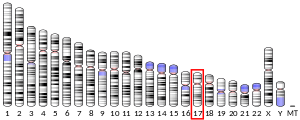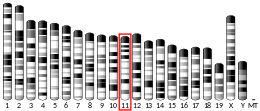MAP2K4
Dual-specificity mitogen-activated protein kinase kinase 4 is an enzyme that in humans is encoded by the MAP2K4 gene.[5]
MAP2K4 encodes a dual-specificity kinase that belongs to the Ser/Thr protein kinase family. MAP2K4 phosphorylates MAP kinases in response to various environmental stresses or mitogenic stimuli. MAPK8/JNK1, MAPK9/JNK2, and MAPK14/p38 are substrates for MAP2K4, but MAPK1/ERK2 and MAPK3/ERK1 are not phosphorylated by MAP2K4. MAP2K4 is phosphorylated and activated by MAP3K1/MEKK1. Knockout mouse studies suggest roles for MAP2K4 in mediating T cell development and liver organogenesis.[6]
Interactions
MAP2K4 has been shown to interact with:
gollark: Perhaps I should make my own unnecessary package manager.
gollark: I'm aware. Sofia said it was chromium.
gollark: I'm pretty sure it's still WebKit.
gollark: Yes, but is the engine they all use Chromium or not?
gollark: Indeed.
References
- GRCh38: Ensembl release 89: ENSG00000065559 - Ensembl, May 2017
- GRCm38: Ensembl release 89: ENSMUSG00000033352 - Ensembl, May 2017
- "Human PubMed Reference:". National Center for Biotechnology Information, U.S. National Library of Medicine.
- "Mouse PubMed Reference:". National Center for Biotechnology Information, U.S. National Library of Medicine.
- Lin A, Minden A, Martinetto H, Claret FX, Lange-Carter C, Mercurio F, Johnson GL, Karin M (May 1995). "Identification of a dual specificity kinase that activates the Jun kinases and p38-Mpk2". Science. 268 (5208): 286–90. Bibcode:1995Sci...268..286L. doi:10.1126/science.7716521. PMID 7716521.
- "Entrez Gene: MAP2K4 mitogen-activated protein kinase kinase 4".
- Xia Y, Wu Z, Su B, Murray B, Karin M (November 1998). "JNKK1 organizes a MAP kinase module through specific and sequential interactions with upstream and downstream components mediated by its amino-terminal extension". Genes & Development. 21 (21): 3369–81. doi:10.1101/gad.12.21.3369. PMID 9808624.
- Marti, A; Luo Z; Cunningham C; Ohta Y; Hartwig J; Stossel T P; Kyriakis J M; Avruch J (January 1997). "Actin-binding protein-280 binds the stress-activated protein kinase (SAPK) activator SEK-1 and is required for tumor necrosis factor-alpha activation of SAPK in melanoma cells". J. Biol. Chem. UNITED STATES. 272 (5): 2620–8. doi:10.1074/jbc.272.5.2620. ISSN 0021-9258. PMID 9006895.
- Lee, Clement M; Onésime Djamila; Reddy C Damodara; Dhanasekaran N; Reddy E Premkumar (October 2002). "JLP: A scaffolding protein that tethers JNK/p38MAPK signaling modules and transcription factors". Proc. Natl. Acad. Sci. U.S.A. United States. 99 (22): 14189–94. Bibcode:2002PNAS...9914189L. doi:10.1073/pnas.232310199. ISSN 0027-8424. PMC 137859. PMID 12391307.
- Park, Hee-Sae; Kim Mi-Sung; Huh Sung-Ho; Park Jihyun; Chung Jongkyeong; Kang Sang Sun; Choi Eui-Ju (January 2002). "Akt (protein kinase B) negatively regulates SEK1 by means of protein phosphorylation". J. Biol. Chem. United States. 277 (4): 2573–8. doi:10.1074/jbc.M110299200. ISSN 0021-9258. PMID 11707464.
- Chen, Z; Cobb M H (May 2001). "Regulation of stress-responsive mitogen-activated protein (MAP) kinase pathways by TAO2". J. Biol. Chem. United States. 276 (19): 16070–5. doi:10.1074/jbc.M100681200. ISSN 0021-9258. PMID 11279118.
- Tournier, C; Whitmarsh A J; Cavanagh J; Barrett T; Davis R J (July 1997). "Mitogen-activated protein kinase kinase 7 is an activator of the c-Jun NH2-terminal kinase". Proc. Natl. Acad. Sci. U.S.A. UNITED STATES. 94 (14): 7337–42. Bibcode:1997PNAS...94.7337T. doi:10.1073/pnas.94.14.7337. ISSN 0027-8424. PMC 23822. PMID 9207092.
- Cheng, J; Yang J; Xia Y; Karin M; Su B (April 2000). "Synergistic interaction of MEK kinase 2, c-Jun N-terminal kinase (JNK) kinase 2, and JNK1 results in efficient and specific JNK1 activation". Mol. Cell. Biol. UNITED STATES. 20 (7): 2334–42. doi:10.1128/MCB.20.7.2334-2342.2000. ISSN 0270-7306. PMC 85399. PMID 10713157.
- Ito, M; Yoshioka K; Akechi M; Yamashita S; Takamatsu N; Sugiyama K; Hibi M; Nakabeppu Y; Shiba T; Yamamoto K I (November 1999). "JSAP1, a novel jun N-terminal protein kinase (JNK)-binding protein that functions as a Scaffold factor in the JNK signaling pathway". Mol. Cell. Biol. UNITED STATES. 19 (11): 7539–48. doi:10.1128/mcb.19.11.7539. ISSN 0270-7306. PMC 84763. PMID 10523642.
- Matsuura, Hiroshi; Nishitoh Hideki; Takeda Kohsuke; Matsuzawa Atsushi; Amagasa Teruo; Ito Michihiko; Yoshioka Katsuji; Ichijo Hidenori (October 2002). "Phosphorylation-dependent scaffolding role of JSAP1/JIP3 in the ASK1-JNK signaling pathway. A new mode of regulation of the MAP kinase cascade". J. Biol. Chem. United States. 277 (43): 40703–9. doi:10.1074/jbc.M202004200. ISSN 0021-9258. PMID 12189133.
Further reading
- Lin, A (2006). "The JNK Signaling Pathway (Molecular Biology Intelligence Unit)". Landes Bioscience. 1: 1–97. ISBN 978-1587061202.
This article is issued from Wikipedia. The text is licensed under Creative Commons - Attribution - Sharealike. Additional terms may apply for the media files.




